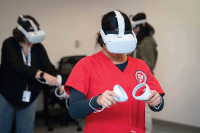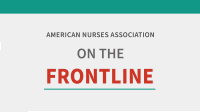Strategies and support to improve mental health outcomes
Suicide and mental illness have long been stigmatized, and although public awareness has grown recently, partially due to the COVID-19 pandemic, many individuals hesitate to acknowledge their own mental health struggles or seek help. Several barriers contribute to this hesitation, including cultural perceptions and beliefs, shame and guilt, lack of family/social support, insufficient numbers of mental health clinicians, variable effectiveness of treatments, socioeconomic disadvantages, and ongoing stress and anxiety in uncertain economic times. Nurses aren’t immune to these barriers and witness them daily. Moreover, nurses face multiple stressors in their professional roles, which result in emotional turmoil, moral distress/injury, and cognitive overload.
Nurses and mental illness
Mental illness, specifically depression and anxiety, among nurses has grown during and after the pandemic. According to research by Davidson and colleagues, suicide rates have been greater among nurses than the general population for 10 years straight. Substance use disorders (SUD) also affect nurses and overlap with suicide when nurses are reported, are suspected of, or lose their licenses due to SUD. Professional responsibilities and distress also influence maladaptive coping and suicide among nurses. Thus, the nursing profession has an obligation to bring awareness of mental illness as a legitimate condition that requires assessment, surveillance, compassion, treatment, and ongoing support. In the work environment, punitive strategies such as reprimanding, generating a performance improvement plan, reporting a nurse to the board of nursing, or terminating a nurse aren’t generally appropriate as a first step.
Intervention and prevention
Improving mental health outcomes for nurses requires a network of support from schools of nursing, training and continuing education resources, nurse leaders, nurse peers and co-workers, and especially employers. Nursing schools can raise awareness of all potential nursing occupational hazards, including infection, physical exertion injuries, sleep deprivation and circadian rhythm disturbances, violence from patients and families, and mental illness. Curriculum can include reviews of mental health struggles and disorders, symptoms, and unique risks for nurses, as well as strategies for self-protection and self-knowledge when intervention and resources are lacking.
In all clinical and educational settings employers and educators will do well to discuss assistance, treatment, and support. Nurse leaders and educators shouldn’t tolerate any mental health stigma or “guilting.”
Employers can demonstrate that they care about employee well-being by taking the following steps:
- Orient new nurses and those in new positions to stressors and mental health resources.
- Offer regular check-ins, mental health assessments, and well-being programs for nurses throughout their careers.
- Provide debriefings with colleagues and supportive leaders such as chaplains, nurse leaders, nursing education specialists, and preceptors to deliver effective coping strategies and support.
- Arrange opportunities to share, receive support, and innovate to improve conditions.
- Supply resources and programs for vicarious and secondary trauma.
- Extend medical leave to allow recovery from mental health crises.
- Assure insurance coverage is part of a nurse’s benefits package and that mental healthcare includes assessment, prevention, treatment, and maintenance.
- Provide crisis intervention with bystander education and training.
Suicidal ideation
Suicidal thoughts are dynamic and can change from moment to moment. They occur when one is feeling alone, isolated, highly uncertain or ambivalent about what to do, or out of control.
Individuals may have a narrowed focus on ending the suffering. When working with someone expressing suicidal thoughts, consider the following strategies:
- Listen actively.
- Ask about their situation, their thoughts, and what makes life so hard in this moment.
- Show empathy, compassion, and a desire to understand.
- Stay with the person.
- Convey hope. Share that the darkness will lift with help and support.
- Ensure professional help arrives.
In addition, check in with yourself about any personal biases, and remain mindful that although you may have different beliefs, your role is to honor the person in crisis and identify what they require. After the crisis, focus on your own self-care needs.
Supportive strategies
Mental Health First Aid, a resource for equipping nurses with crisis intervention skills, provides training in how to identify a mental health or SUD issue or crisis and offer initial assistance. This typically 8-hour course is available to anyone. Learners receive education on the signs and symptoms of mental health and SUD issues, initial interventions, how to link those in crisis to more in-depth help, and additional resources for assistance. Several providers offer the courses.
Psychological safety, another strategy for supporting nurses’ well-being, centers around ensuring that employees feel comfortable expressing themselves fully, questioning the status quo, and effecting change without fear of retribution from their employer or other team members. This type of work culture promotes interpersonal growth, collaboration, a willingness to change, creativity, and camaraderie. It decreases the fear of failure and enhances the learning experience. Edmonson recommends focused team performance communication, with leaders encouraging questions, ideas, and criticism. Edmonson and Hugander recommend team and individual coaching, visualizing future scenarios, and planning for success; however, if failure occurs, use it as a learning experience. They also suggest that teams should normalize openness and vulnerability, making it standard practice.
Experience of a nurse under stress
Mary*, a new graduate nurse, is assigned to a burn unit with adult and pediatric patients. She has just moved away from family and is starting a new life. She works full-time, assigned mostly 12-hour night shifts. Mary faces devastating patient conditions with families in crisis and patients suffering substantial pain and agony during treatments. For example, Mary cares for a toddler, who, when left in the care of a mother’s boyfriend, was immersed in scalding water intentionally from the waist down, causing second- and third-degree burns resulting in multiple surgeries and skin grafts. She also cares for an electric company employee who received untreatable internal electrical burns.
Mary is offered a 1-year nursing residency and moves quickly into her role as a result of a severe nursing shortage. She feels ill-prepared to independently care for patients and their families. She has trouble falling asleep and awakes frequently imagining patients screaming from unspeakable pain. She’s developed unhealthy eating habits and doesn’t have the energy to prioritize exercise. She approaches her preceptor about the emotional toll of her position but receives little guidance. Mary is uncomfortable approaching managers with her personal struggles. She feels like she doesn’t belong, that she chose the wrong profession, and doesn’t know what to do or who to turn to. Given her lack of external support, she’s desperate.
*fictitious name
Nursing-specific resources for mental health support
In 2020, in response to the pandemic, the American Nurses Foundation (the Foundation) launched the Well-Being Initiative (nursingworld.org/thewellbeinginitiative), which offers tools and resources for nurse mental well-being, including the 24/7 Happy warm line, Moodfit app, a gratitude toolkit, a mental health assessment tool, gratitude podcasts, and more. This resource is free to all nurses.
The American Nurses Association’s (ANA) Nurse Suicide Prevention/Resilience website (nursingworld.org/nurse-suicide-prevention) provides a compendium of nurse suicide prevention resources. These include nurse suicide statistics and research studies, suicide prevention information and helplines, grief and bereavement resources, information related to honoring those lost to suicide, and material for suicide survivors.
ANA also offers several opportunities for nurses to learn more about suicide and mental health risks and strategies for supporting themselves and their colleagues. These include the online courses Suicide Among Nurses: What We Don’t Know Might Hurt Us (tinyurl.com/3nbk8ptj) and Promoting Nurse Self-Care: Emotional And Mental Wellbeing (tinyurl.com/3wsefbu6), as well as the See You Now podcast Focus on Mental Health (tinyurl.com/ysyrajfu). ANA members also can learn burnout prevention strategies while earning CE through SE Healthcare Burnout Prevention Program, which offers dozens of video-based training modules (tinyurl.com/y9t9cshk).
ANA Enterprise offers the online Healthy Nurse, Healthy NationTM program at hnhn.org. This free nurse wellness program focuses on six domains: mental health, quality of life, safety, rest, nutrition, and physical activity. Participants can take a health survey, make health commitments, connect with others, engage in friendly competition in health challenges, and access resources. HNHN also gives nurses a voice to tell their stories via blogs and social media.
The Foundation recently launched the Stress and Burnout Prevention Pilot Program to support nurses in addressing burnout, managing stress, and increasing their confidence (tinyurl.com/2s3te96n). Its content will be adapted by nurses for nurses. This customized program will provide access to real-time resources and tools to help nurses understand the science behind what they are experiencing, and how to manage moments of extraordinary stress. Notably, the Stress and Burnout Prevention Pilot Program also will create a shared language around stress and burnout to lessen the stigma nurses may encounter when in need of help. The Foundation is piloting the program in four healthcare organizations representing over 15,000 nurses in rural and urban locations in a variety of settings.
The Ohio State University prioritizes well-being and mental health for students, faculty, clinicians, and staff. A resource created during the pandemic addresses how to help a clinician in mental distress (u.osu.edu/cliniciansindistress). This resource also is available to anyone engaging with and assisting a colleague, peer, or other healthcare member in mental and emotional distress or having suicidal thoughts. The site provides intervention guidance along with videos depicting strategies for responding to clinicians in distress.
The hard work and dedication of nurses requires acknowledgement and appropriate compensation. The sacrifices and challenges nurses face must not be glamorized, ignored, or hidden. Nurses need mental health support, assessment, resources, and treatment throughout their careers so that they can better care for patients and offer healing and health to their communities as well as themselves.
— Sharon Tucker is associate dean for Health Promotion and Well-being and Grayce Sills Endowed Professor in Psychiatric-Mental Health Nursing in the College of Nursing at The Ohio State University and an ANA member. Holly Carpenter is a senior policy advisor for ANA. Anna Mujic is an RN at the Mayo Clinic in Rochester, Minnesota.
I need mental health help now. Contact:
- 988
- 911
- Local emergency room
- Your healthcare provider
I may need mental health help soon. Explore:
- National Alliance on Mental Illness (nami.org)
- Your employer, which may have an employee assistance program or other resources
- Your health insurance and benefits provider
- Your place of worship
References
Billings J, Ching BCF, Gkofa V, Greene T, Bloomfield M. Experiences of frontline healthcare workers and their views about support during COVID-19 and previous pandemics: A systematic review and qualitative meta-synthesis. BMC Health Serv Res. 2021;21(1):923 doi:10.1186/s12913-021-06917-z
Choflet A, Barnes A, Zisook S, et al. The nurse leader’s role in nurse substance use, mental health, and suicide in a peripandemic world. Nurs Adm Q. 2022;46(1):19-28. doi:10.1097/NAQ.0000000000000510
Choflet A, Davidson J, Lee KC, Ye G, Barnes A, Zisook S. A comparative analysis of the substance use and mental health characteristics of nurses who complete suicide. J Clin Nurs. 2021;30(13-14):1963-72. doi:10.1111/jocn.15749
Clifton J, Harter J. Culture Shock. Washington, DC: Gallup Press; 2023.
Davidson JE, Choflet A, Earley MM, et al. Nurse suicide prevention starts with crisis intervention. Am Nurse J. 2021;16(2):14-8.
Davidson JE, Proudfoot J, Lee K, Terterian G, Zisook S. A longitudinal analysis of nurse suicide in the United States (2005-2016) with recommendations for action. Worldviews Evid Based Nurs. 2020;17(1):6-15. doi:10.1111/wvn.12419
Edmondson AC. Leading in tough times: HBS faculty member Amy C. Edmonson on psychological safety. Harvard Business School. November 22, 2022. www.hbs.edu/recruiting/insights-and-advice/blog/post/leading-in-tough-times
Edmondson AC, Hugander P. 4 steps to boost psychological safety at your workplace. Harvard Business Review. June 22, 2021. hbr.org/2021/06/4-steps-to-boost-psychological-safety-at-your-workplace
Institute of Medicine (US) Committee on Enhancing Environmental Health Content in Nursing Practice; Pope AM, Snyder MA, Mood LH, editors. Nursing Health & Environment: Strengthening the Relationship to Improve the Public’s Health. B Environmental Hazards for the Nurse as a Worker. Washington, DC: National Academies Press; 1995. ncbi.nlm.nih.gov/books/NBK232400/
National Council of Mental Wellbeing. Mental Health First Aid Research in the United States. February 2023. mentalhealthfirstaid.org/wp-content/uploads/2023/03/2023.03.01_MHFA_Research-Summary_infographic.pdf
Thornicroft G, Sunkel C, Alikhon Aliev A, et al. The Lancet Commission on ending stigma and discrimination in mental health. Lancet. 2022;400(10361):1438-80. doi:10.1016/S0140-6736(22)01470-2
Tucker S. Identifying and intervening with a suicidal colleague. In: Davidson J, Richardson M, eds. Workplace Wellness: From Resiliency to Suicide Prevention and Grief Management: A Practical Guide to Supporting Healthcare Professionals. (2023). New York City, NY: Springer; 2023; 349-362.
Varghese A, George G, Kondaguli SV, Naser AY, Khakha DC, Chatterji R. Decline in the mental health of nurses across the globe during COVID-19: A systematic review and meta-analysis. J Glob Health. 2021;11:05009. doi:10.7189/jogh.11.05009




















